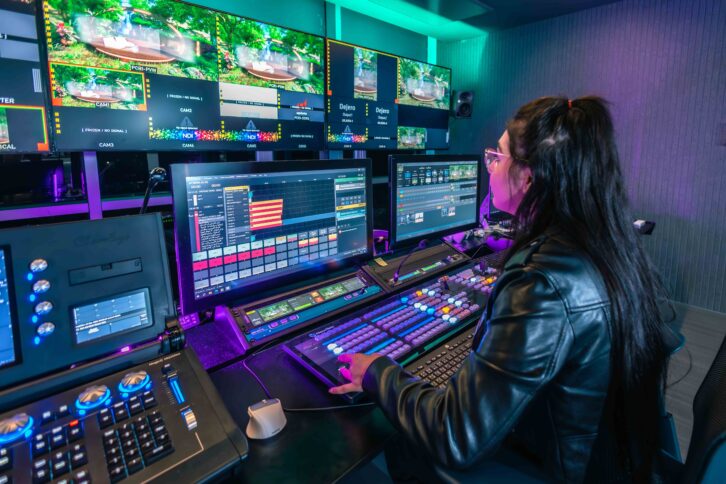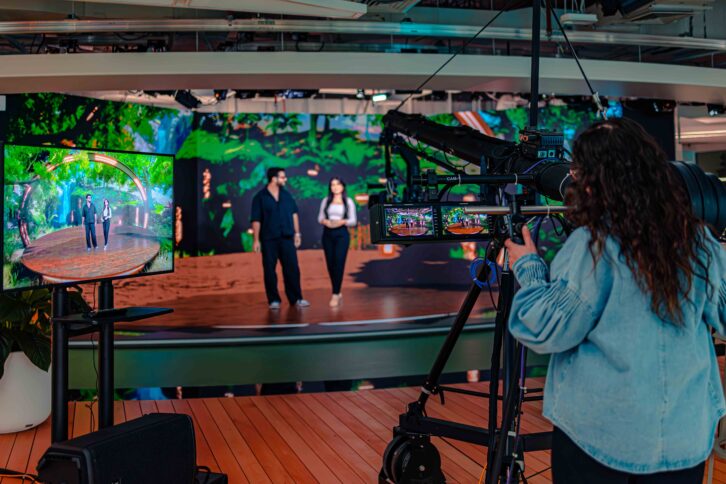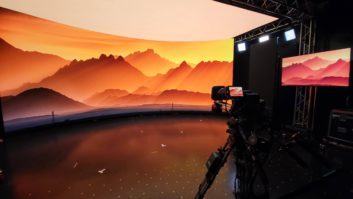Broadcasters have long faced the challenge of how to attract younger viewers. This is now harder than ever, not only in keeping existing audiences but drawing in the millennial and Generation Z age groups, most of whom rely on mobile devices, YouTube and TikTok for their entertainment and information. News outlets in particular are facing the challenge of how to engage those born at the beginning of this century without undermining or trivialising important stories and issues.
A news broadcaster facing up to this test right from the start is the recently launched Dubai-based blinx Digital Media Hub. Going ‘on-air’ from purpose-built studios in September 2023, blinx is aiming to bring news to the youth of the Middle East using up-and-coming young talent and the latest virtual production techniques. Among its offerings are talk shows, investigative reporting and live broadcasts, although the core of its programming is short informative packages. All this is available across a variety of screens, platforms and devices, plus the dedicated blinx Smart TV app.
While blinx promotes itself with the slogan ‘By the Youth, for the Youth’, it has seasoned professionals in senior managerial positions. The general manager is Nakhle Elgage, former director of news at Middle East Broadcasting Corporation (MBC); chief creative officer Fadi Radi held a similar role at Al Alarabiya news channel as well as being head of graphics for MBC.

“The main focus was about Gen Z because the media outlets targeting them [in the Middle East] are very limited and most of them are either foreign or not regional,” Radi says. “They also don’t want traditional media talking to them and trust the people [presenters and personalities] more than entities. Which is why we hired fresh graduates or people with very low profiles and started to grow them to be our storytellers.”
As part of this, Radi adds, the ambition was for creative storytelling but with a grounding in “what we have learned from the news industry over many years.” Another aspect of the concept on which blinx is based is to be digitally native and not depend on traditional broadcast technology. To develop what Radi describes as “futuristic platforms and workflows”, he approached Vizrt, with which he had worked at other broadcasters over the past 20 years.
“Because we wanted to be digital native, everything is NDI-based,” he says. “We also talked about remote production, full automation and multi-platform output publishing into both horizontal – mainly for YouTube, Facebook and our TV app – and vertical – for other platforms – formats. At the same time, we wanted an elevation for the storytelling and discussed with Vizrt the possibility of having what is used at the moment in Hollywood and for high-end productions.”

This brief led to the creation of what blinx calls its Metaverse Studio, which features extended reality (XR) sets supported by production facilities with virtual reality (VR) capability and AI (artificial intelligence) enhancements. The virtual sets with AR and interactive graphics are created using Viz Virtual Studio, Viz Engine and Viz Pilot Edge, with vision mixing on a TriCaster production switcher.
While blinx’s ambitions to be digital native have been mostly achieved through the NDI (Network Device Interface) protocol for networking and connectivity, there is, at least at this early stage, some older technology as part of the installation. “There are a few dedicated islands that are SDI because of the timescale for going live,” explains Vizrt chief technology officer Gerhard Lang. “The XR sets, for example, were not so easy to produce with NDI because of the frame accuracy and latency. At the time it was implemented, synchronising tracking data with NDI sources in a multi-camera set-up was not reliable enough, so we’re handling it with SDI from the cameras into the boxes.”
The focus of attention on the blinx installation, which Lang describes as “very ambitious”, is understandably on elements such as AR and the virtual sets. But more traditional broadcast equipment is also part of the mix; as well as TriCaster there is a central newsroom computer system (NRCS), albeit one based on evolving technology. The 7Mountains DiNA NRCS works in conjunction with the Mimir video collaboration and production platform; both are hosted in the cloud with the two companies being part of Fonn Group.

Fadi Radi says the cloud connectivity enables journalists and presenters to log on to the main system from wherever they might be working in the world, with full access to the graphics package through Viz Pilot Edge. As for sticking with the established newsroom set-up, Radi explains it is integrated with current metaverse techniques, with each influencing the other. “We created the system [with] the credibility of the NRCS and brought that into the social media or digital media world. Everything is done on a newsroom system. We have a MAM [media asset management] system for everything that is coming in from wire services or stock institutions. It all goes into the same workflow of a traditional TV service when it comes to credibility, proper copyright and fact-checking.”
As much as recent TV centres have been designed to be pleasant places to work, most are still largely functional and based on established office and studio layouts. Radi comments that the intention with blinx was to have a mix of technology and nature that would be conducive to the creative process. “We added a lot of nature into the place, with plants and other things,” he says. “It is a studio, a shooting place, where people can film whatever they want. There is a natural feeling for people to love where they’re working, so they can sit and talk freely and produce the content they want.”
In terms of the tools available, there are two tracking systems, which Radi describes as being able to create any AR possibilities. “We also have the XR set for any VR experience, which are totally different from chroma-keying or green screen because of the interactivity involved. The presenter is able to see the output of the story they are telling and can live the experience while at the same time explaining it in a nice way to the audience. That has created more interactivity and means you don’t need a really professional presenter, you need young storytellers telling things they way they are seeing it.”
Since the 1980s efforts have been made to update the image of TV news programmes through the use of graphics or more basic gimmicks like having the newscaster stand in front of a desk instead of sitting behind it. The implementation of today’s virtual technologies at blinx could be seen as an extension of that, even though another of the platform’s mottos is “More Story, Less Noise.” Radi responds with the old adage less is more: “We just use the minimal graphical elements that are needed to explain a story, no matter how far we can go with that. If it is a story about space, we can build the XR set and telelport the storytellers into space. If an item requires only a listicle, we can mention some of the elements and create a list to go with it.”
In the first three months of operation, blinx built up in the region of 700,000 followers, with many of its stories now going viral. Far from being disconnected and in their own little world, later millennials and Gen Zers, at least in the Middle East, are making sure they are informed and connected to their region.







